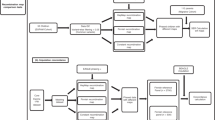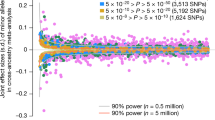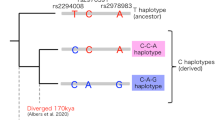Abstract
We studied how well the European CEU samples used in the Haplotype Mapping Project (HapMap) represent five European populations by analyzing nuclear family samples from the Swedish, Finnish, Dutch, British and Australian (European ancestry) populations. The number of samples from each population (about 30 parent-offspring trios) was similar to that in the HapMap sample sets. A panel of 186 single nucleotide polymorphisms (SNPs) distributed over the 1.5 Mb region of the GRID2 gene on chromosome 4 was genotyped. The genotype data were compared pair-wise between the HapMap sample and the other population samples. Principal component analysis (PCA) was used to cluster the data from different populations with respect to allele frequencies and to define the markers responsible for observed variance. The only sample with detectable differences in allele frequencies was that from Kuusamo, Finland. This sample also separated from the others, including the other Finnish sample, in the PCA analysis. A set of tagSNPs was defined based on the HapMap data and applied to the samples. The tagSNPs were found to capture the genetic variation in the analyzed region at r2>0.8 at levels ranging from 95% in the Kuusamo sample to 87% in the Australian sample. To capture the maximal genetic variation in the region, the Kuusamo, HapMap and Australian samples required 58, 63 and 73 native tagSNPs, respectively. The HapMap CEU sample represents the European samples well for tagSNP selection, with some caution regarding estimation of allele frequencies in the Finnish Kuusamo sample, and a slight reduction in tagging efficiency in the Australian sample.
Similar content being viewed by others
Log in or create a free account to read this content
Gain free access to this article, as well as selected content from this journal and more on nature.com
or
References
The International HapMap Consortium: A haplotype map of the human genome. Nature 2005; 437: 1299–1320.
Conrad DF, Jakobsson M, Coop G et al: A worldwide survey of haplotype variation and linkage disequilibrium in the human genome. Nat Genet 2006; 38: 1251–1260.
de Bakker PI, Burtt NP, Graham RR et al: Transferability of tag SNPs in genetic association studies in multiple populations. Nat Genet 2006; 38: 1298–1303.
Sawyer SL, Mukherjee N, Pakstis AJ et al: Linkage disequilibrium patterns vary substantially among populations. Eur J Hum Genet 2005; 13: 677–686.
Mueller JC, Lohmussaar E, Magi R et al: Linkage disequilibrium patterns and tagSNP transferability among European populations. Am J Hum Genet 2005; 76: 387–398.
Ribas G, Gonzalez-Neira A, Salas A et al: Evaluating HapMap SNP data transferability in a large-scale genotyping project involving 175 cancer-associated genes. Hum Genet 2006; 118: 669–679.
Gu S, Pakstis AJ, Li H, Speed WC, Kidd JR, Kidd KK : Significant variation in haplotype block structure but conservation in tagSNP patterns among global populations. Eur J Hum Genet 2007; 15: 302–312.
Zhu G, Montgomery GW, James MR et al: A genome-wide scan for naevus count: linkage to CDKN2A and to other chromosome regions. Eur J Hum Genet 2007; 15: 94–102.
Boomsma DI, de Geus EJ, Vink JM et al: Netherlands Twin Register: from twins to twin families. Twin Res Hum Genet 2006; 9: 849–857.
Spector TD, Williams FM : The UK Adult Twin Registry (TwinsUK). Twin Res Hum Genet 2006; 9: 899–906.
Service S, DeYoung J, Karayiorgou M et al: Magnitude and distribution of linkage disequilibrium in population isolates and implications for genome-wide association studies. Nat Genet 2006; 38: 556–560.
Leon DA, Koupil I, Mann V et al: Fetal, developmental, and parental influences on childhood systolic blood pressure in 600 sib pairs: the Uppsala Family study. Circulation 2005; 112: 3478–3485.
Miller SA, Dykes DD, Polesky HF : A simple salting out procedure for extracting DNA from human nucleated cells. Nucleic Acids Res 1988; 16: 1215.
Bell PA, Chaturvedi S, Gelfand CA et al: SNPstream UHT: ultra-high throughput SNP genotyping for pharmacogenomics and drug discovery. Biotechniques 2002; 32 (Suppl): 70–72,74, 76–77.
Barrett JC, Fry B, Maller J, Daly MJ : Haploview: analysis and visualization of LD and haplotype maps. Bioinformatics 2005; 21: 263–265.
de Bakker PI, Yelensky R, Pe’er I, Gabriel SB, Daly MJ, Altshuler D : Efficiency and power in genetic association studies. Nat Genet 2005; 37: 1217–1223.
Gabriel SB, Schaffner SF, Nguyen H et al: The structure of haplotype blocks in the human genome. Science 2002; 296: 2225–2229.
Stephens M, Scheet P : Accounting for decay of linkage disequilibrium in haplotype inference and missing-data imputation. Am J Hum Genet 2005; 76: 449–462.
Stephens M, Smith NJ, Donnelly P : A new statistical method for haplotype reconstruction from population data. Am J Hum Genet 2001; 68: 978–989.
The Wellcome Trust Case Control Consortium: Genome-wide association study of 14 000 cases of seven common diseases and 3000 shared controls. Nature 2007; 447: 661–678.
Duerr RH, Taylor KD, Brant SR et al: A genome-wide association study identifies IL23R as an inflammatory bowel disease gene. Science 2006; 314: 1461–1463.
Sladek R, Rocheleau G, Rung J et al: A genome-wide association study identifies novel risk loci for type 2 diabetes. Nature 2007; 445: 881–885.
Willer CJ, Scott LJ, Bonnycastle LL et al: Tag SNP selection for Finnish individuals based on the CEPH Utah HapMap database. Genet Epidemiol 2006; 30: 180–190.
Varilo T : The age of the mutations in the Finnish disease heritage a genealogical and linkage disequilibrium study. PhD thesis, University of Helsinki, Finland; on-line publications, Helsinki, 1999, pp 1–98.
Service S, Sabatti C, Freimer N : Tag SNPs chosen from HapMap perform well in several population isolates. Genet Epidemiol 2007; 31: 189–194.
Stankovich J, Cox CJ, Tan RB et al: On the utility of data from the International HapMap Project for Australian association studies. Hum Genet 2006; 119: 220–222.
Acknowledgements
Genotyping was performed at the SNP technology platform in Uppsala (www.genotyping.se). The study was supported by the EC-funded GenomEUtwin project (QLG2-CT-2002-01254), the Swedish Research Council and the Knut and Alice Wallenberg Foundation. We thank Megan Campbell for preparation of the Australian samples.
Author information
Authors and Affiliations
Corresponding author
Additional information
Supplementary Information accompanies the paper on European Journal of Human Genetics website (http://www.nature.com/ejhg)
Rights and permissions
About this article
Cite this article
Lundmark, P., Liljedahl, U., Boomsma, D. et al. Evaluation of HapMap data in six populations of European descent. Eur J Hum Genet 16, 1142–1150 (2008). https://doi.org/10.1038/ejhg.2008.77
Received:
Revised:
Accepted:
Published:
Issue date:
DOI: https://doi.org/10.1038/ejhg.2008.77
Keywords
This article is cited by
-
LOXL1 gene variants and their association with pseudoexfoliation glaucoma (XFG) in Spanish patients
BMC Medical Genetics (2015)
-
Rapid method for growth hormone receptor exon 3 delete (GHRd3) SNP genotyping from archival human placental samples
Endocrine (2015)
-
Evaluating the transferability of Hapmap SNPs to a Singapore Chinese population
BMC Genetics (2010)
-
DDOST, PRKCSH and LGALS3, which encode AGE-receptors 1, 2 and 3, respectively, are not associated with diabetic nephropathy in type 1 diabetes
Diabetologia (2010)
-
A comprehensive analysis of common genetic variation in MUC1, MUC5AC, MUC6 genes and risk of stomach cancer
Cancer Causes & Control (2010)



